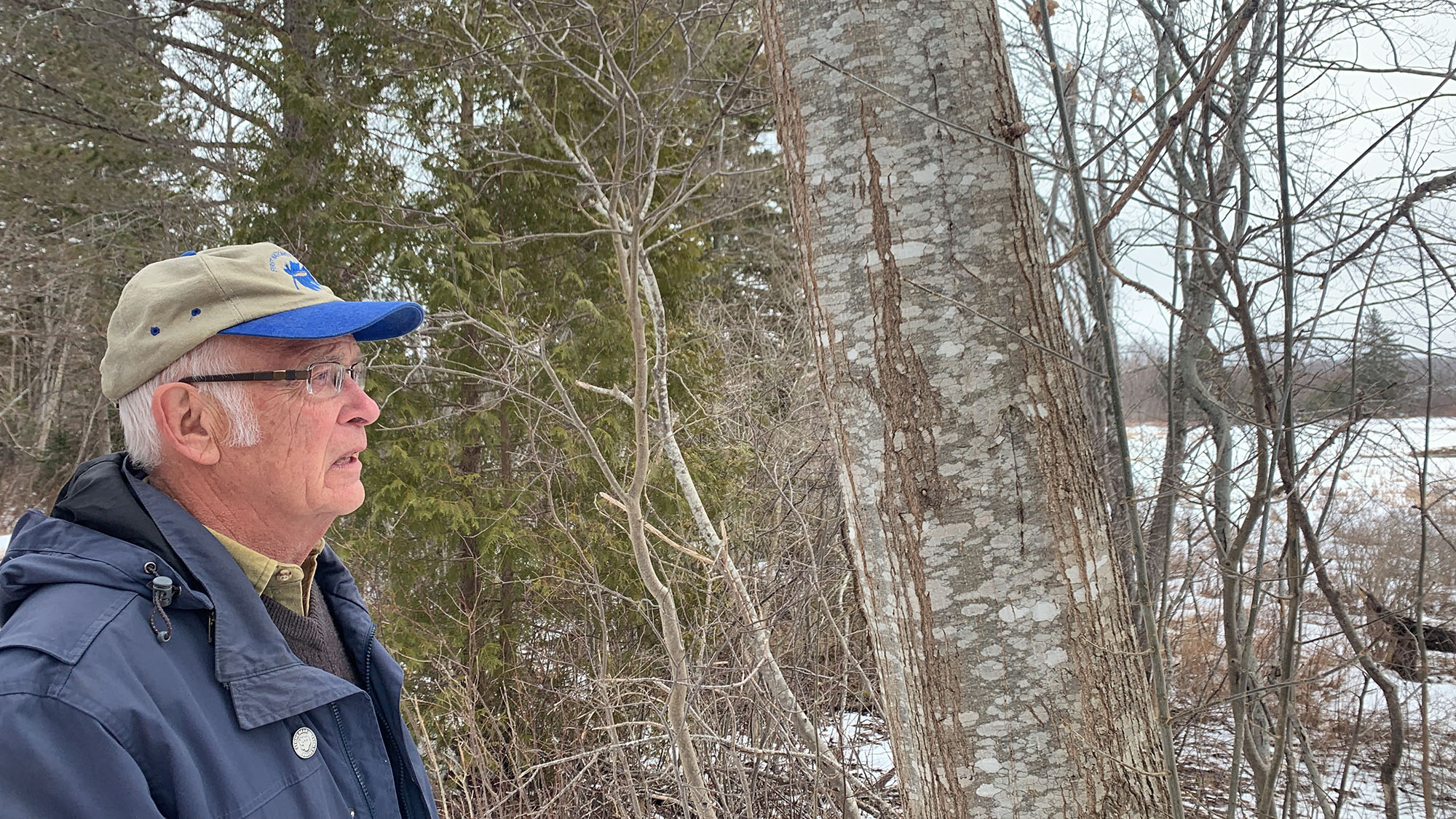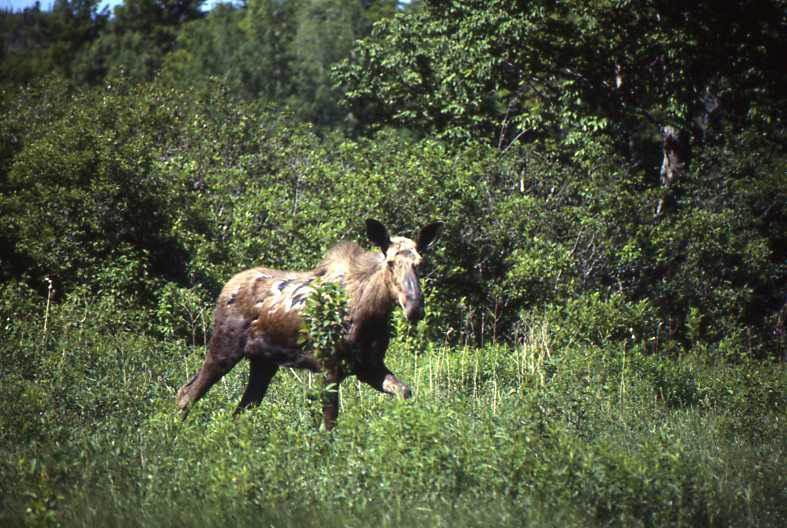ALCES ALCES AMERICANA: a biologist fights to keep mainland moose alive

caption
Former provincial biologist turned activist Bob Bancroft explains what kind of environment the mainland moose need to survive in Nova Scotia.Biologist fights his former department to save mainland moose in Nova Scotia
The biologist heard a noise.
He crouched beneath branches of alders, keeping as quiet as possible.
But it did not matter. The animal noticed. He was impossibly large — bigger than a car. It was a monumental beast that, with one single move, could kill.
Bob Bancroft remained hidden — or so he thought — until the moose glanced at him, standing his ground, a mere metre-and-a-half away. One easy stomp could end it all. But Bancroft was not afraid. Instead of running, he lay down on the forest ground.
The large male with giant antlers and Bancroft locked eyes, existing in silence, with nothing but forest around them. Then the moose moved. A black shadow disappearing through the woods.
Bancroft exhaled in awe. He had just witnessed Canadian royalty — an extremely rare and increasingly sporadic occurrence: Nova Scotia’s endangered mainland moose.
The Nova Scotia Department of Natural Resources and Renewables listed the province’s moose population as endangered in its “species at risk” registry in 2003. But the department does not fund annual surveys on moose, so an accurate number today is unknown, though estimates point to about 700.
The numbers have been decreasing over the years. A status report says that in the early 1700s, there were over 15,000 moose in the province. In 1920, the population was estimated to have been 7,000. A total ban on hunting was implemented in 1937, yet by 2003, moose numbers had decreased to 1,000.
Population decline is largely attributed to two major threats: clear-cutting and brain-worm infections. But traditional threats are also an issue, like predators, coyotes, black bears and poaching.
In 2004, the N.S. government assembled a recovery team to come up with a plan to increase mainland moose numbers. The team produced a recovery plan by 2007, and it was approved by the government in 2012. Initially, Bancroft was a part of that team.
But then he got frustrated. Progress was slow. The animals were still in danger. After studying moose for over 30 years, he wanted change. “Biologists were not given enough support,” he said.
Bancroft left his job. His former colleagues would become adversaries.
He filed a series of lawsuits alleging the provincial government failed to meet obligations to protect moose under the Endangered Species Act. The first one was unsuccessful, but it paved the way to a second one that put the provincial Department of Natural Resources and Renewables under scrutiny.
“I was told by certain people that the government had secretly written off the mainland moose,” Bancroft said. “They shook their heads and told me it was a done deal.”
Undeterred, Bancroft prepared for the fight of his life.
The legal battle
The first lawsuit was heard in June 2019, but it was dismissed due to a lack of evidence on Bancroft’s behalf. Then he refiled a second lawsuit, which went to trial Sept. 23, 2019. Justice Christa M. Brothers of the Supreme Court of Nova Scotia presided over the case.
“The lawsuit became political,” said William Lahey, former deputy minister for environment and labour and the current president, vice-chancellor and law professor at the University of King’s College.
In 2018, Lahey, alongside seven contributors, produced an independent evaluation of forest practices for Nova Scotia. This report was updated twice, in 2020, and again in 2021. The evaluation confirmed deforestation practices like “clear-cutting” were extremely detrimental. This type of cutting, also known as variable retention cutting, consists of cutting down trees to a point where botanical regrowth is difficult. Moose, then, are left without a natural habitat.
Lahey’s report provoked conversation about forestry management throughout the province. The report was also referenced during the suit.
Liberal MLA Iain Rankin, who would go on to become premier before losing in the 2021 election, was the minister of lands and forestry at the time — another name for the Department of Natural Resources and Renewables. His lawyer initially tried to have the case ruled inadmissible on grounds of ineligibility. But the judge approved the case.
Bancroft’s lawyer argued that the natural resources minister had not taken proper measures to foster a natural environment for moose to thrive in. He cited clear-cutting as the biggest problem. He also argued moose populations were unknown due to the lack of surveys and that such lack of data reflected how the minister had not kept to recovery plan schedules.
Bancroft stressed timelines set out in the recovery plan had not been met, and therefore the minister had failed to meet obligations under the Endangered Species Act.
Court records indicate the minister’s lawyer failed to submit convincing affidavits as part of evidentiary support for the proceedings.
The lawsuit’s outcome would not come until months later. By May 2020, the COVID-19 pandemic forced Bancroft to learn the outcome at home.
He opened his computer to find the email he had been waiting for. Bancroft printed out the 50-page document with anxiety.
Finally, he faced the verdict.
The judge agreed with Bancroft and ruled the natural resources minister had failed to protect the mainland moose, as per his obligations under the Endangered Species Act.
The very first sentence in the judge’s ruling was a quote from the Dr. Seuss book The Lorax: “Unless someone like you cares a whole awful lot, nothing is going to get better. It’s not.”
The government’s response
Rankin ceased to be the minister of lands and forestry on Oct 13, 2020. He was later elected Nova Scotia Liberal Party leader and premier before losing to the Progressive Conservatives on Aug. 17, 2021. Today, the minister overseeing the department is Tory Rushton.
Rushton declined a request for an interview. However, a biologist working for the department recognized the lawsuit “brought about necessary actions.” Indeed, once the lawsuit unfolded, the court imposed legal obligations on the ministry.
Justice Brothers ordered an update on the mainland moose recovery plan. The plan was instructed to have new timelines, as well as designate new areas of ecological preservation.
The updated mainland moose recovery plan was published in November 2021.
New numbers on moose are set to be out by the end of 2024. The last comprehensive survey was published in 2003.
When asked why funding is not provided annually to count moose, Rushton replied in a written statement, “Surveys for mainland moose are being conducted within the three main concentration areas” through helicopters and moose health protocols. By moose health protocols, he means the analysis of pellets moose drop as they roam forests — the more droppings biologists find, the more moose in the area.
The three concentration areas of focus for surveys are: the Colchester and Cumberland forests; Antigonish, Guysborough and Pictou zones; and the Tobeatic region. All of these areas are on Crown land.
Rushton said these surveys are done on a rotating basis and “as weather conditions permit.” This means conditions to undertake surveys are not always present — sometimes snow is needed and other times, biologists need clear skies to view moose from above. Therefore, surveys are not done on a yearly basis.
Regarding clear-cutting, Rushton said the “conservation zone is 35 per cent of Crown land. No forestry activity is permitted in this zone.” He said through this model, “less clear-cutting will happen on Crown land.”
Clear-cutting is legally allowed outside said conservation zones.
In reference to current moose numbers, Rushton said: “It’s a complex process to designate the core habitat for mainland moose identified in the recovery plan. It involves formal legal description of the lands, and consultation and notification of property owners and interested parties. We are actively working on it, but we anticipate it will take several years to complete.”

caption
Photography donated by Bob Bancroft showing a mainland moose, donated July 10, 2023
Bancroft today
With the court battles behind him, Bancroft wanted to take further steps to ensure the animal’s safety. His organization launched a petition to request minister Rushton designate new core areas as moose habitat.
As president of Nature Nova Scotia, Bancroft is setting up teams of volunteers to track moose throughout the province to “accumulate better data on moose populations.”
“We don’t have numbers,” Bancroft said. “If the government won’t do it, we will.”
As of today, governmental surveys rely heavily on moose sightings. The Department of Natural Resources and Renewables has set up a website where people can report sightings of mainland moose.
These reports, combined with helicopter tracking and moose health protocols, are big components of the numbers the department is expected to release by 2024. Bancroft believes he can better the system by bringing volunteers in.
“The fact of the matter is the government window dresses,” Bancroft said. “They implement laws in theory, but they end up approving projects that counter the development of nature. At some point, the people have to step in and do the work the government does not want to do.”
Bancroft believes moose are an indicator of how well nature is doing. He does not want to see them perish.
“I would be devastated if we get to a point where the last moose in Nova Scotia dies,” Bancroft said. “But I hope we don’t get to that. I hope one day Nova Scotians can look at our nature and think to themselves, ‘We can save them.’”
About the author

Abel Rangel
Abel Rangel is a screenwriter and journalist working and living in Halifax, N.S. He earned a master’s degree in transgender studies at New...
